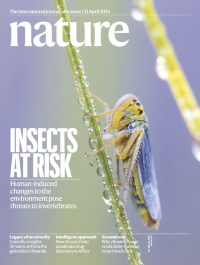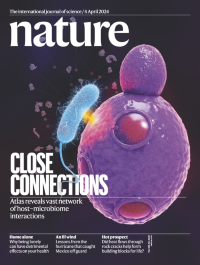Volume 628
-
No. 8007 11 April 2024
Insects at riskThe cover shows a green leafhopper (Cicadella viridis). Five papers in this week’s issue explore the environmental challenges now facing insect populations, with climate change emerging as a key factor whose influence has potentially been underestimated. Jörg Müller and colleagues analyse 27 years of insect biomass data to reveal that weather anomalies associated with climate change can affect insect biomass in the temperate zone. In a second paper, Melanie Kazenel and co-workers find that warming caused by climate change could pose a threat to bee diversity in the United States, and a paper by Guillaume Ghisbain and colleagues predicts significant reduction in suitable habitat for European bumblebee species owing to human-induced changes to the environment, including climate change. Another human effect is highlighted in a paper by Charlie Nicholson and co-workers, which looks at the negative effects of pesticide use on bumblebees in Europe. And a fifth paper by Roel van Klink and colleagues probes how declines in formerly abundant species can drive insect loss.
-
No. 8006 4 April 2024
Close connectionsHuman physiology is affected by the huge range of microorganisms that make up the microbiome, but the molecular bases for these effects are largely unknown. In this week’s issue, Noah Palm, Aaron Ring and colleagues present an atlas of interactions between human tissues and the microbiota. The researchers devised a system called BASEHIT that uses yeast clones to display human extracellular and secreted proteins (exoproteins), which are then screened for interactions with hundreds of commensal bacteria known to inhabit different tissues in the human body. The resulting interactome revealed thousands of previously unknown molecular-level host–microbe interactions. The cover shows an artist’s impression of one such interaction between a bacterium and a BASEHIT yeast cell.


